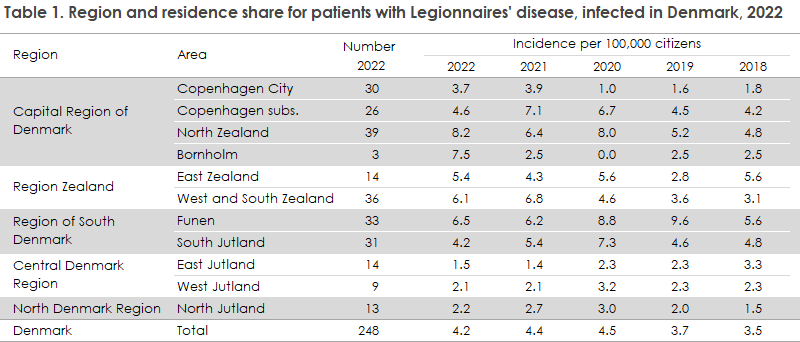No 22 - 2023
Legionnaires' disease in Denmark 2022
Legionnaires' disease in Denmark 2022
2022 saw a total of 287 recorded cases of legionnaires' disease (LD) among Danish citizens living in Denmark, including 169 men (20-95 years, median age 73 years) and 118 women (28-96 years, median age 76 years). A total of 248 cases were presumably infected in Denmark (86.4%), see Table 1. This is a slightly lower level than observed in 2020 and 2021, whereas an increase was once again seen in the number of persons who had become infected abroad after the COVID-19 pandemic. In 2022, a total of 39 cases became infected during stays abroad (13.6%). Most of these cases became infected in Italy from where 15 cases were recorded; the second most frequent country of infection was the United Arab Emirates with 8 cases.
For a detailed epidemiological description of the 2022 incidence, please see the 2022 Annual Report on Legionnaires’ Disease.
In 2022, a total of 56 (19.5%) of those notified during the year with LD died within one month after disease onset or hospitalisation. The mortality has increased in recent years, which is likely associated with an increasing share of elderly people among those diagnosed with LD. In 2022, 63% of the registered cases were ≥ 70 years, and the mortality in this age group was 27.2%. The mortality was especially high among cases who had probably become infected at a hospital (63.2%), whereas cases infected during travels abroad (2.6%) was the group recording the lower mortality.

The areal distribution in 2022 (Table 1) was roughly on a par with that recorded in 2021. However, a decline was seen in Copenhagen Subs. and an increase was observed in North Zealand. Once more, Copenhagen City recorded a higher detected incidence than in previous years. The island of Bornholm recorded a high incidence in 2022 but - due to its low population count - the incidence is sensitive to slight changes in the number of detected cases. A relatively large interregional incidence difference remains between the Capital Region of Denmark, the Zealand Region and the Region of South Denmark, on one hand, and the Central Denmark Region and the North Denmark Region, on the other. No outbreaks or clusters have been detected that may explain increases or differences.
The increasing demands for energy savings, including savings on hot water due to the energy crisis in late 2022, are not estimated to have caused more cases than expected as an even decline was observed in the number of people who had become infected in Denmark from October (30 cases) to December 2022 (16 cases).
We encourage PCR testing for Legionella species and for L. pneumophila, as a PCR positive test for Legionella species has a very low predictive value for diagnostics of LD, and some samples therefore need to be considered false positives or of unknown clinical value. It is also important to remain aware that some mild cases or cases seen in the early phase of the course (e.g., without productive cough) of Legionnaires' disease are not PCR positive (probably around 20-30%) as it may be difficult to obtain sampling material of a sufficient quality and the Legionella content may be very low. Some of these patients have a serogroup-1-infection and may frequently be detected by Legionella urine test instead, whereas some particularly mild cases will probably test negative regardless of the test used.
(S. A. Uldum, Department of Bacteria, Parasites & Fungi. C. Kjelsø, Department of Infectious Disease Epidemiology and Infection)